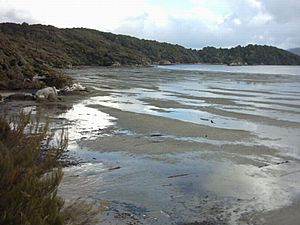Mudflat facts for kids
Imagine a wide, flat area along the coast that appears and disappears with the ocean tides! These special places are called mudflats or tidal flats. They are coastal wetlands that form in calm areas like bays, lagoons, and river mouths. Here, the ocean's tides and rivers drop off tiny bits of sand, mud, and other materials, building up these flat lands.
Mudflats are found all over the world. A study published in 2019 showed they cover a huge area, about 127,921 square kilometers (49,391 square miles). That's as big as all the mangrove forests on Earth! You can find many of them in countries like Indonesia, China, and Australia. About 44% of the world's mudflats are in Asia.
These amazing areas are usually covered by water twice a day when the tide comes in, and then exposed when the tide goes out. This constant change makes them unique habitats.
In the past, people sometimes thought mudflats were not very useful. They were even filled in to create farmland. However, we now know how important they are for nature.
Some mudflats can be very tricky to walk on. For example, in places like Anchorage, Alaska, the mud is made of very fine silt. It can quickly become like quicksand if you step on it. Many people need rescuing from these areas each year, especially when the tide comes in. In Germany, some mudflats are exposed by strong winds pushing the water away, not just by the tides. These are called Windwatt.
Contents
The Amazing Ecology of Mudflats
Mudflats are incredibly important natural areas, just like salt marshes and mangrove forests. They are home to a huge variety of plants and animals. These wetlands are a vital stop for millions of migratory birds. These birds travel long distances from their breeding grounds in the north to warmer places in the south.
Home to Many Creatures
Many different creatures thrive in mudflats. You can find various types of crabs, mollusks (like clams and snails), and fish. In the United Kingdom, mudflats are recognized as a special habitat that needs protection.
Protecting Our Coasts
Mudflats also play a big role in protecting our coasts. They help prevent the land from being washed away by the sea.
How Mudflats Are Made
Mudflats are built up by layers of sand and mud. These layers are mostly found in the intertidal zone, the area between high and low tide. The way these layers build up depends on things like how much mud and sand rivers bring in, and changes in sea level.
Some parts of mudflats are mostly bare, with lots of sand near the water channels. Other parts are like marshes, full of herbaceous plants (plants with soft stems). In marshes, you'll find thinner layers of sand and mud. You might also see Mudcracks, which are cracks in the dried mud. These marsh areas can even form layers of coal or peat over very long periods, from all the decaying plants.
There are also "salt pans" within mudflats. These areas have thin layers of clayey silt, mostly brought by rivers. When the mud dries out, the wind can even form small silt dunes. Then, when the tide or rain comes back, these dried sediments are spread around again.
Threats to Mudflats
Sadly, mudflats around the world are facing many dangers. Rising sea levels are a big concern, as they could permanently cover these areas. People also sometimes fill in mudflats for new buildings, farms, or factories. Shipping activities can damage them through dredging. Pollution from chemicals is another serious threat.
What's Happening to Mudflats?
In some parts of the world, especially in East Asia, many mudflats have been lost. For example, around the Yellow Sea, over 65% of mudflats present in the 1950s were gone by the 2000s. It is estimated that about 16% of the world's tidal flats have disappeared since the mid-1980s.
Places to Explore Mudflats
Mudflats are found in many places around the globe. Here are a few examples:
- Arcachon Bay, France
- Banc d'Arguin, Mauritania
- Great Rann of Kutch, India
- Bridgwater Bay and Morecambe Bay, United Kingdom
- Cape Cod Bay, Massachusetts, United States
- Cook Inlet, Alaska, United States
- Minas Basin, Nova Scotia, Canada
- Wadden Sea: Netherlands, Germany, Denmark
- West coast of Andros Island, Bahamas
- Yellow Sea: China, North Korea, South Korea (known as Getbol)
Learn More
- Getbol






